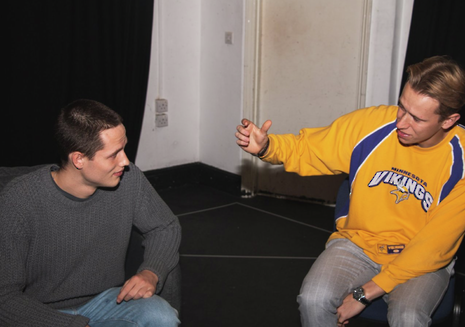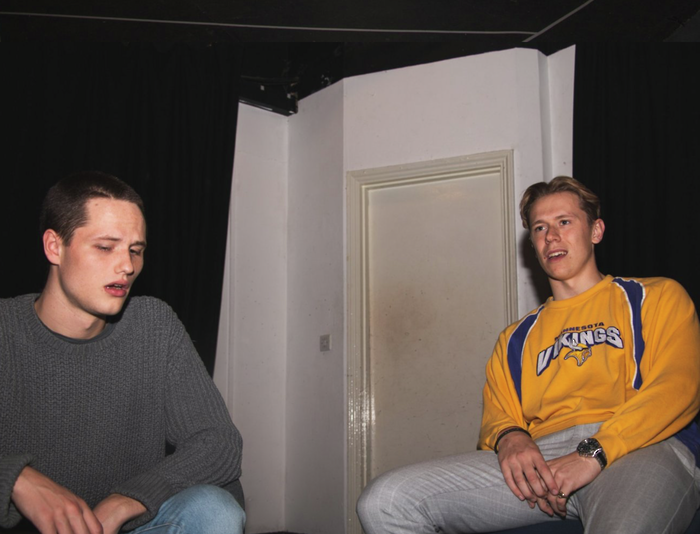Big Boys Don’t Cry addresses the ignorance surrounding male mental health, but lacks solutions
Tom Foreman’s debut play offers important food for thought about societal pressures on young boys, but fails to present opportunities for countering these problems.

Content note: This article contains discussion of suicide.
Boys don’t cry. Big boys in particular don’t cry. The Clash already addressed this notion and needless to say, tribute is paid to them in this play. Toxic masculinity prevents men from revealing weakness and vulnerability which often prevents the showing of any emotion. A study from the Office for National Statistics in the UK not only indicates that males are three times more likely to commit suicide than females, but that the suicide rates among particularly young men are drastically increasing.
This is the context for Big Boys Don’t Cry, a new play by Tom Foreman addressing male mental health in adolescence, a time of turmoil and change. Ben (Foreman) and Oscar (Will Leckie) met on their first day in school and have been best friends growing up. They made it through childhood and puberty together but drifted apart after beginning university. Now, they are young adults and meet each other for the first time in years. Avoiding speaking of times long gone, they try to live in the moment, but the past doesn’t want to be forgotten.
One of the strengths of the play are the flashbacks. Creating these believably on stage, especially within seconds, can be difficult, but director Emily Webster finds several ways that help the audience to follow the non-linear narrative. The poignant use of music, sound effects, and lighting indicates the many, and often sudden, changes of time and setting. Playing Britney Spears during a club scene or the use of convincing recordings such as voice messages help the audience and provide little breaks to breathe within otherwise quickly paced sequences. Moreover, the use of certain props such as school bags or adjustments to the costumes (shirt tucked in or out) guide the viewer in their piecing together of the back-story that leads up to Ben and Oscar’s meeting in the present.
“The poignant use of music, sound effects, and lighting indicates the many, and often sudden, changes of time and setting.”
The actors adjust quickly in the well-timed changeovers, yet the pace of certain sequences could be the reason why Foreman’s acting sometimes lacks force. It helps that he and Leckie - whose doubling as Chessie, a girl Ben befriends, is believable and shows his range as an actor - have good chemistry. Together, they can guide the audience through the flashbacks and sudden time-jumps which appear indicative of the way adulthood - and the expectations that come with it - can approach blazingly fast and before adolescents are ready to enter it.
Although they could at times be even more pertinent, the flashbacks and consequent foreshadowing allow the viewer to piece together the various triggers that eventually result in the play’s climax. However, the play could have taken a stronger stance on the topic it addresses while also offering strategies that tackle the very issue the play sheds light on. It circles around suicide without ever explicitly naming it, leaving my companion wondering if that was actually what was being referred to. Especially with such an important topic, I believe the play could have taken a more direct approach, both in writing and directing, to enforce the dramatic events that unfold as a result of the notion that ‘big boys don’t cry’. A more explicit strategy of how these events could have been prevented would have added an additional layer to the play.
Ben and Oscar feel that adolescence and the verge to adulthood should be an exciting time, but instead realise that it’s putting a lot of pressure and unrealistic expectations on them, resulting in them having to come to terms with and negotiate their own perception and performance of manhood and masculinity. That these expectations, that include the public showing of emotions or even affection, the seeking of help in times of distress, and also the expectation of attending university, have been imprinted on boys from an early age is hinted at almost in every scene. As one of the boys reveals, society and parents often do not allow taking a step back or showing vulnerability, because boys are expected to handle the change well, to not complain, and get on with their lives.
The pain of this is dealt with particularly well in one scene depicting both boys high. The lighting by Deasil Waltho creates a fitting atmosphere here, supporting the boys’ free talk about their issues, anxieties, and desires. It emphasises how big of an issue the ignorance of male’s mental health really is when even the closest of friends feel the need to hide their true feelings of despair and depression from one another.
Big Boys Don’t Cry doesn’t make use of its full potential and could push boundaries even more by tackling the issues it covers head-on. It outlines various reasons that eventually result in a tragedy without really offering strategies to counter it. Still, Foreman’s debut play is a solid addition to the important discussion around male mental health and food for thought.
 Features / Should I stay or should I go? Cambridge students and alumni reflect on how their memories stay with them15 December 2025
Features / Should I stay or should I go? Cambridge students and alumni reflect on how their memories stay with them15 December 2025 News / Cambridge study finds students learn better with notes than AI13 December 2025
News / Cambridge study finds students learn better with notes than AI13 December 2025 Comment / The magic of an eight-week term15 December 2025
Comment / The magic of an eight-week term15 December 2025 News / News In Brief: Michaelmas marriages, monogamous mammals, and messaging manipulation15 December 2025
News / News In Brief: Michaelmas marriages, monogamous mammals, and messaging manipulation15 December 2025 News / Uni Scout and Guide Club affirms trans inclusion 12 December 2025
News / Uni Scout and Guide Club affirms trans inclusion 12 December 2025










